Blog
NCAA rules on consolidating universities

The NCAA Division II Membership Committee has ruled on athletic programs at consolidating universities. Click here for statements from APSCUF’s coach executive leader and president.
Legislative assembly elects officers, honors service
 Delegates begin their day of speakers, reports, and discussion at APSCUF’s legislative assembly, held April 8–9 at the Sheraton Harrisburg Hershey Hotel in the Harrisburg area. It was first in-person assembly since February 2020. Photos/Kathryn Morton
Delegates begin their day of speakers, reports, and discussion at APSCUF’s legislative assembly, held April 8–9 at the Sheraton Harrisburg Hershey Hotel in the Harrisburg area. It was first in-person assembly since February 2020. Photos/Kathryn Morton
At APSCUF’s 211th legislative assembly, delegates and officers discussed ongoing issues, heard committee reports, elected new officers and committee members, honored retirees, and welcomed a guest speaker. They met April 8–9 at the Sheraton Harrisburg Hershey Hotel in the Harrisburg area — their first in-person assembly since February 2020.
Recurring topics were consolidation, retrenchment, higher-education affordability, funding for Pennsylvania’s State System of Higher Education, and student debt.
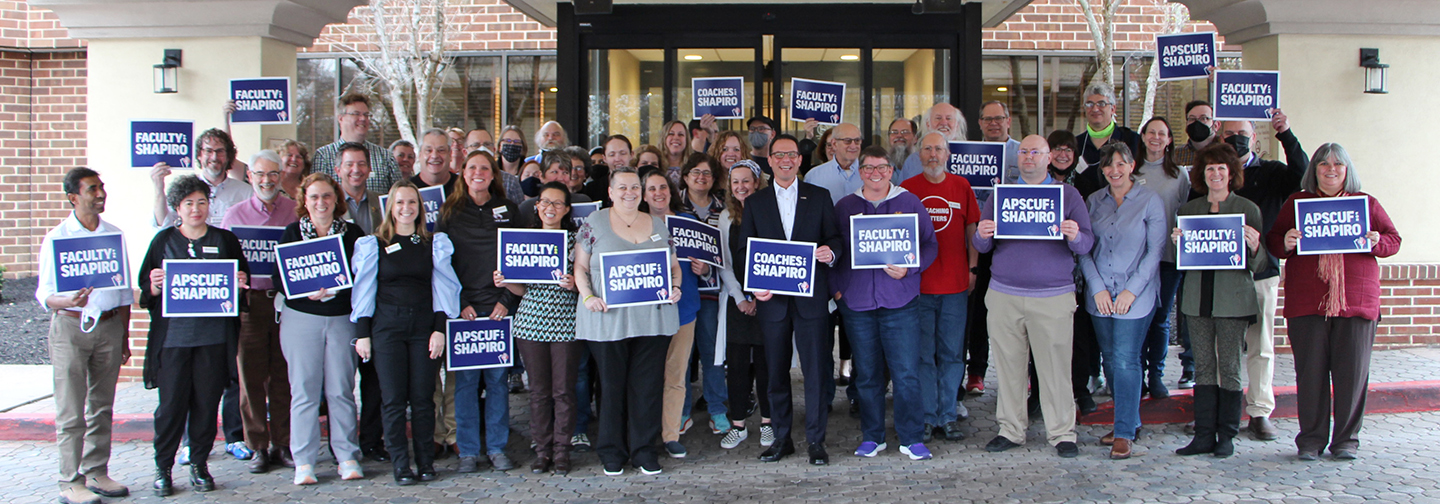 Delegates and officers take a group photo with Josh Shapiro, Pennsylvania gubernatorial candidate, center in navy suit, after he spoke to APSCUF’s legislative assembly April 8.
Delegates and officers take a group photo with Josh Shapiro, Pennsylvania gubernatorial candidate, center in navy suit, after he spoke to APSCUF’s legislative assembly April 8.
Guest and Pennsylvania Attorney General Josh Shapiro, candidate for governor, spoke about higher-education and labor issues. He is APSCUF’s endorsed candidate for governor.
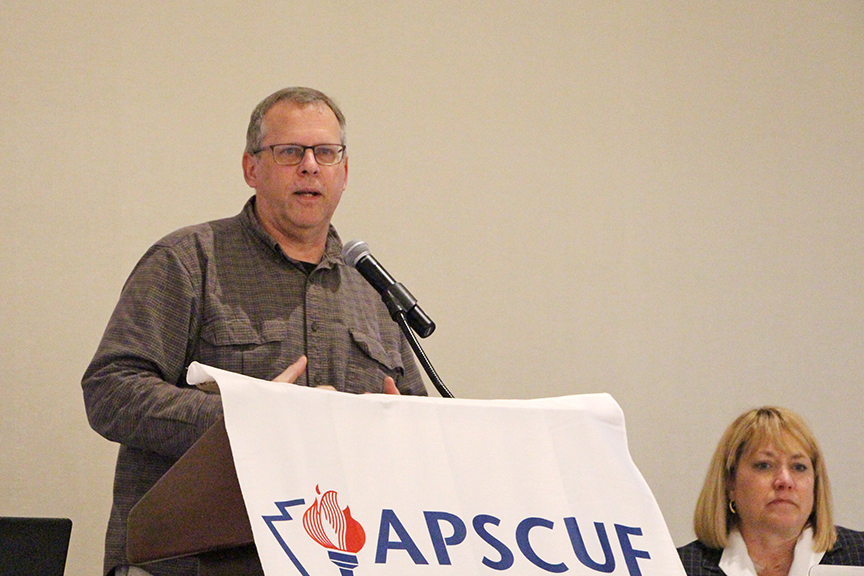
Coach Executive Leader John Gump of Kutztown University, above, updated delegates on the coaches’ issues and discussed how APSCUF has strengthened coaches in the more than two decades since they became part of the union.
At Friday’s awards dinner, APSCUF honored retirees with distinguished service awards and a union leader as a friend of APSCUF. All three awards presentations had been delayed due to the COVID-19 pandemic.
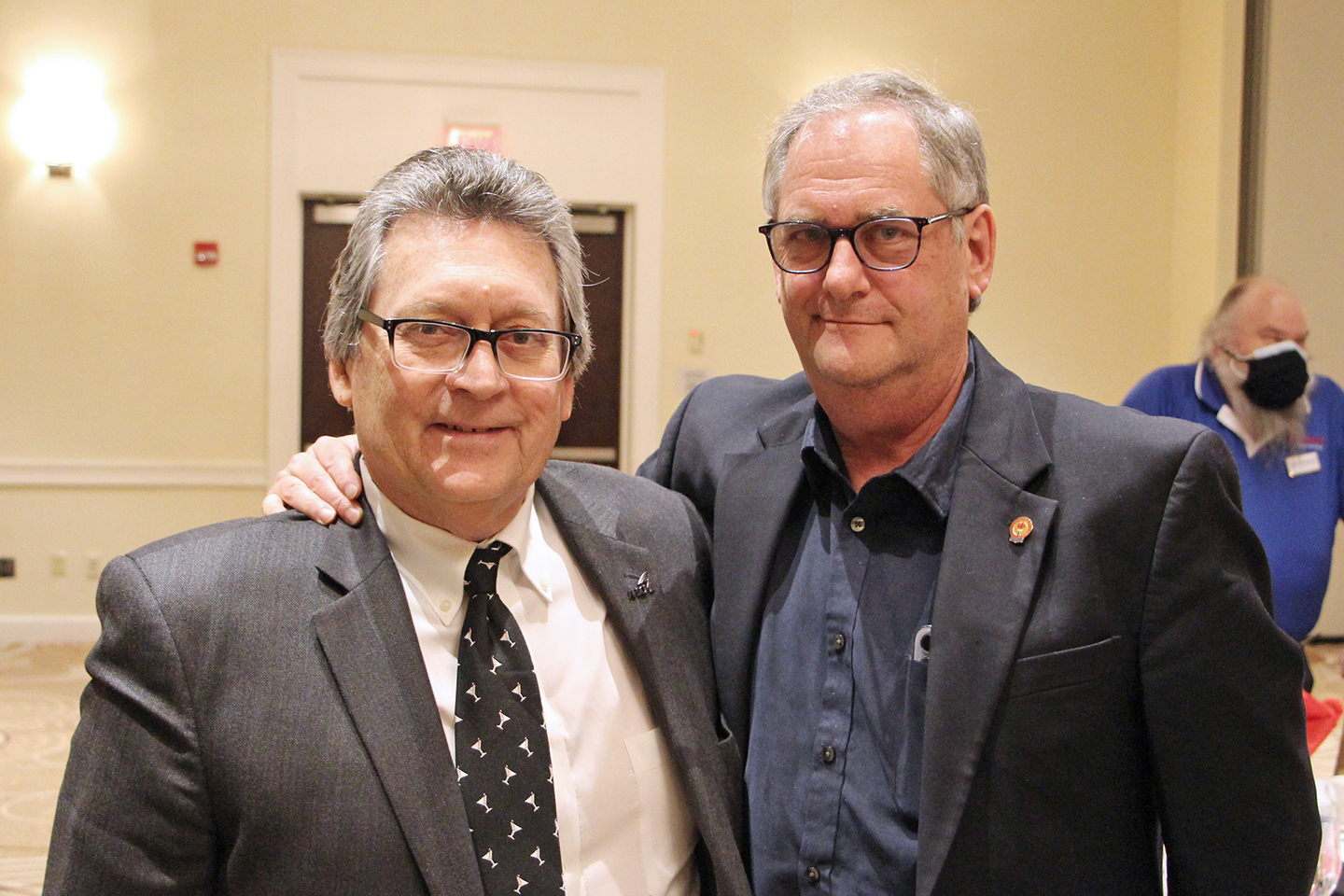
Dr. Kenneth M. Mash, right, introduced David Fillman, executive director of AFSCME Council 13 from 2002 until his retirement in 2021. Both described how the unions have supported one another.

Past APSCUF President Dr. James White, right, spoke about Lisa Demko, retired executive secretary, honored for distinguished service on APSCUF’s staff. She described how APSCUF evolved and diversified throughout her more than 30 years with the union.
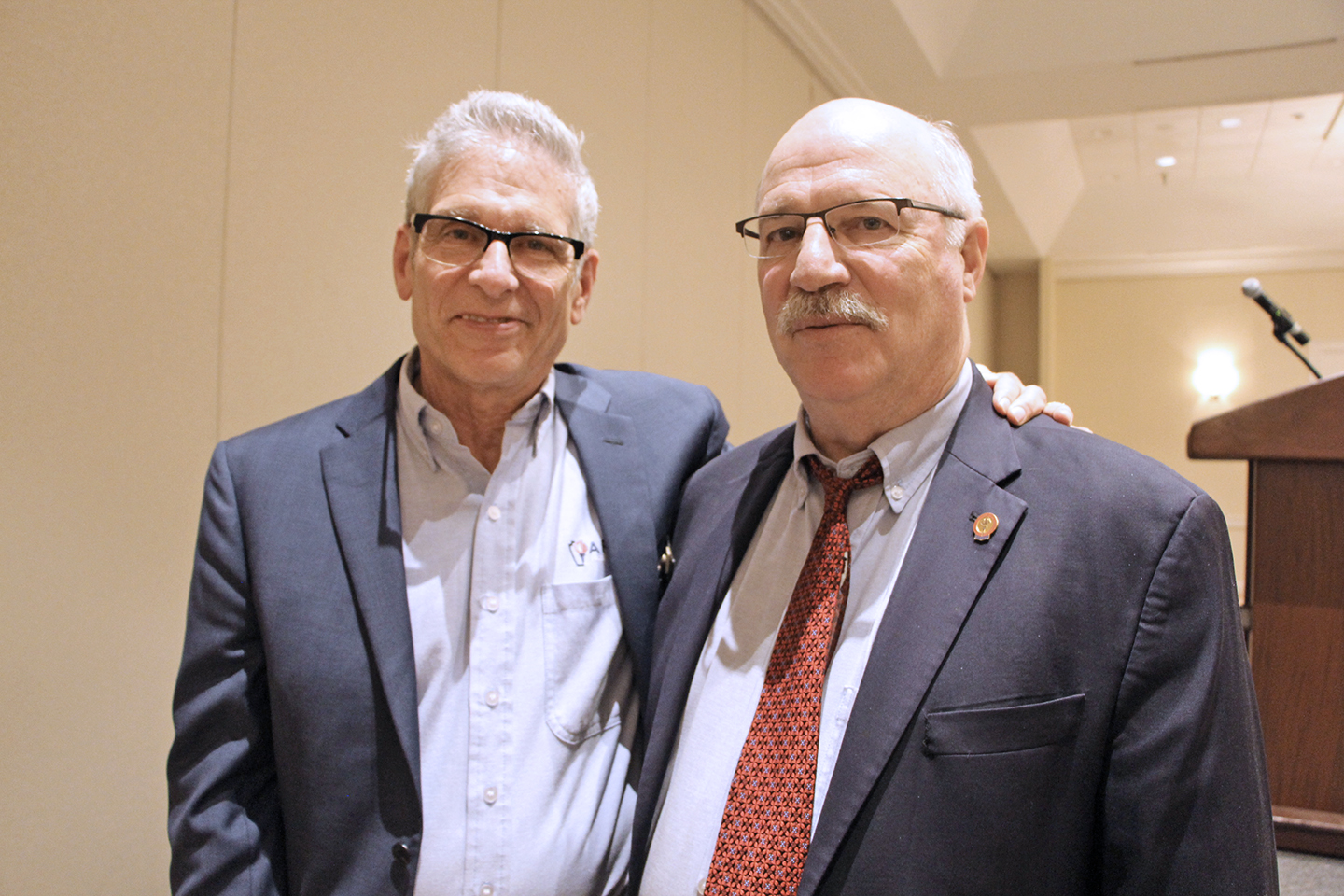
Past APSCUF President Dr. Steve Hicks, right, introduced Dr. Allan Benn, retired from East Stroudsburg University, who was honored for his distinguished service. Benn shared advocacy and negotiations stories from throughout this time with the union.
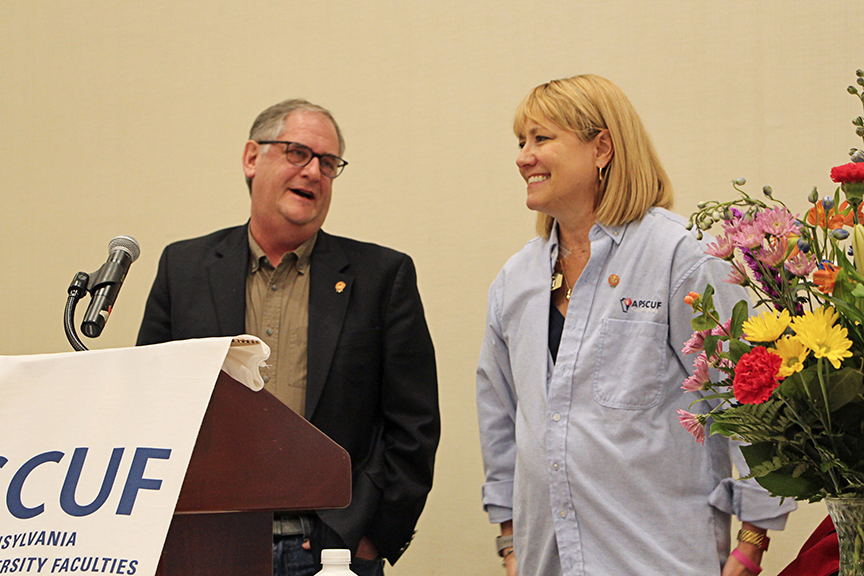
Dr. Kenneth M. Mash, left, and Dr. Jamie Martin address delegates at APSCUF’s legislative assembly April 9 in Harrisburg. Delegates elected officers and committee members for 2022–24 terms.
In Saturday’s elections, delegates voted Dr. Kenneth M. Mash the next APSCUF president, a position he previously held from 2014 to 2020. President Dr. Jamie Martin did not seek reelection due to medical treatment. Delegates reelected Dr. Christopher Hallen of Bloomsburg University as vice president; Dr. Michele Papakie of Slippery Rock University as secretary; and John Gump of Kutztown University as coach executive leader. Dr. Thomas Stewart of Kutztown University was elected treasurer. Delegates elected to the audit committee: Dr. Ellen Foster (Clarion), Dr. Eric Hawrelak (Bloomsburg), and Dr. Heide Witthöft (Indiana). Elected to the budget committee were Susan Drummond (Indiana) and Dr. Michael Malcolm (West Chester). The terms of these positions run June 1, 2022, to May 31, 2024. Click here to read more about the election.
Delegates approved a statement calling on President Joe Biden to cancel all federally held student-loan debt. Click here to read the statement.
Click here to view assembly photos on APSCUF’s Facebook page.
See Dr. Jamie Martin’s remarks to the Board of Governors – April 14, 2022
The April 14 Board of Governors meeting was streamed via YouTube. Below are APSCUF President Dr. Jamie Martin’s comments as prepared.
Chairwoman Shapira, Chancellor Greenstein, governors, university presidents and guests,
Good morning.
Last week, elected delegates from the 14 state-owned and state-funded universities met in Harrisburg for our 211th legislative assembly. This was our first face-to-face meeting since I became president in 2020. It was good to see all of my colleagues in three dimensions.
I want to speak today about what I learned from that meeting. While everyone shared my excitement at seeing friends and colleagues, a pall hung over the assembly room. Over the lunch break, I met with the chapter presidents and asked the 14 to identify some good news from their campuses. Here is some of what I heard: “Jamie, if I tried to find some good news, I would weep.” Another said, “I have to pass on that one,” and another said, “I’ve got nothing.” If I had one word to describe the faculty, it would be “exhausted.” However, being a professor, I cannot use only one descriptor. On several campuses, morale is at an all-time low; faculty are overworked; and on most campuses — and, more problematic — I am seeing faculty begin to disengage. I need to talk about why this is happening and the impacts of it on the faculty and, more important, our students.
To do this, I will focus on 4 R’s: Retirements, Retrenchment, Recruitment and Retention. We all know what the past two years have been like globally and more locally on our campuses. I do not need to rehash that here. Due in part to the challenges in the last two years and in part because of retirement incentives, nearly 10% of the faculty systemwide have retired (or will retire) by the conclusion of this academic year. This has resulted in the loss of seasoned faculty members who have a breadth of experience and institutional memory that is hard to replace. And, in many cases, new faculty lines are not authorized to replace these retirements, nor are adjunct faculty being hired — and I must explain why.
One of the requirements of the sustainability plans is that each university must return to the student/faculty ratio that existed in the mid-2000s, when our enrollments were at their peak. The student/faculty ratios are identified as a measure of efficiency. But I wonder: If it is a measure of efficiency, why are there 14 different ones? I was in the classroom during those years, and it was no panacea. The discipline-specific introductory class that I taught with a typical enrollment of 45 swelled to 125. Could I teach an auditorium class? Sure. Was it the same experience for the students? I’ll let you be the judge of that. My upper-division courses were likewise larger, so it was challenging for me to write letters of recommendation or to provide information to individuals in the criminal-justice system conducting background checks on students that I had in class.
The classes that our retired faculty and adjuncts previously taught still have to be delivered. This has resulted in many faculty members being asked to teach additional classes on overload. Hence, they are teaching additional classes that have more students than before, and this actually costs more than it saves. Apparently, the increased costs of overloads are worth it in order to meet the student/faculty ratio, as the more faculty you have, the lower the ratio. But faculty do more than just teach classes.
Advising is critically important for our students, and doing it well is time-consuming. You must be able to assist them in understanding their curriculum requirements; talk with them about their progress in classes; link them to campus resources if needed; speak with them about career and employment opportunities; and provide other assistance that a student may need. Just as class sizes are growing, the number of advisees that a faculty member has is increasing. This results in less time one can devote to these students — and good advising is linked to retaining students.
In addition to teaching their classes and advising students, faculty are expected to engage in scholarly activities and in service activities — and both are diminished. It is important to stay engaged in research activities; this helps one stay current in their discipline and students benefit when their professor can share their expertise. In my discipline and many others, there is an expectation that we attend professional conferences to present our research findings. However, university budgets have been shrinking, and so have professional-development funds that provide support.
Providing service to one’s department, college, university, and the community or the academy is the third area in which faculty are expected to be engaged. But I am learning of the difficulty of finding faculty members to volunteer and/or run for universitywide, collegewide and department-level committees. Many of the committees that are critical to the functioning of the university are “heavy workload” ones, but with fewer faculty who have less time, committee work of that magnitude is overwhelming.
As I said, faculty are exhausted and beginning to disengage. That is what is happening on all our campuses — and it is exacerbated on the campuses that experienced retrenchment in 2020 and those facing it now and on the six that are in the process of being consolidated. Morale is at an all-time low on these campuses.
Of critical importance at PennWest and Commonwealth University is the development of the curriculum for each new university, and the faculty are hard at work on this in both regions. They are working on discipline-specific curriculum that will require the blending of departmental curriculum requirements that may be very different across the current universities. It will require the determination of departmental requirements for students — by faculty spread across multiple universities. This has been hampered by the restructuring of departments and colleges. As part of this reorganization, some departments are now in different colleges, some departments have been split, others have been merged, and some programs will no longer exist. Beyond departmental curricula, the general-education component will have to be developed. This is a difficult challenge, and developing the general-education requirements should be a thoughtful and interactive one with much input from the faculty at all six universities. In some meetings that have occurred, we have heard some say that the faculty are excited: They are not. The amount of time and effort that developing a new curriculum will take is considerable, and I continue to hear how overwhelmed they are.
Now, let’s consider the impact on our students. We have heard — and we know — just how important increasing enrollments are for our universities. The two ways to do that are to bring in new students, including transfer students, and to retain more of those students when they arrive on a campus. Clearly, affordability is a major factor in both of these efforts — increased funding and lower student-debt loads.
But other factors are important as well: having the programs that are of interest to students — and that includes more than just workforce-development types of degree programs. It means getting to know your classmates and your faculty members in a meaningful way, in the classroom and out of it. It means finding a welcoming and inclusive environment. It means being able to access critical student services. But what we are seeing on many of our campuses is antithetical to these goals. As I mentioned, class sizes are increasing, as are the number of advisees. A spinoff of the reduction in the number of faculty is difficulty in offering enough electives for our students. I know from my time in the classroom — and as the chair of our department — that students are often angered when a class that they wish to take is not being offered. In short, opportunities for students are being constricted not enhanced.
The reduction in the AFSCME workforce has meant fewer department secretaries who are often the first point of contact for students, longer waits at administrative offices, fewer groundskeepers, etc.
The faculty at PennWest and Commonwealth have heard from students that they are very concerned about what to expect at these universities next fall. Recruitment of new students has been hampered by the uncertainty that exists. Faculty at the six consolidating schools worry that enrollments will be negatively impacted and have wondered aloud, “Why would a student come to a consolidated university knowing that they will have to take online courses, when they can go to Slippery Rock or East Stroudsburg and know they will have face-to-face courses?”
Further, at these two new universities, it is still unclear how many online classes a student will have to take to progress toward graduation. While this is related to the curriculum development, the course schedules at our universities are recommended by chairs but must be approved by deans. Hence, the administration at the two new universities will have to decide on which campus courses will be taught and the modality. If a course is taught in person at Bloomsburg, students from Lock Haven and Mansfield will ostensibly have to take that course via Zoom. It is possible that students on some campuses will need to enroll in more online courses than students on other campuses. Given our experiences during the pandemic, how do we prevent these students from being disenfranchised and having a lesser experience than their classmates who are in the physical classroom? This is going to be even more complicated in disciplines that require labs or studios, and when disciplines will only exist on one of the campuses. For example, if a student at Clarion wants to major in chemistry, but the chemistry major only exists at California, how will that work?
Our coaches and student-athletes are still awaiting the decision of the NCAA. Their spring meeting is next week, and there is a chance that they will consider the continuation of athletic teams at each campus of the consolidated universities. We are hopeful that all the athletic teams that currently exist will be able to compete after the consolidation. But I know that one coach that I spoke with is trying to figure out if the NCAA will allow for the PennWest Clarion Golden Eagle basketball team to compete against the PennWest Edinboro Fighting Scots basketball team. If the NCAA decides that sports teams at a single accredited university cannot compete against another team at the same accredited university, what then? What does that mean for the athletes who are on scholarships and for those who are not?
I want to conclude by talking about the second pass around the lunch table with the 14 chapter presidents last Friday. They began to tell me about the positives that they are seeing: collaboration among the six at the consolidating universities; a university receiving R2 status; students preparing to present their research papers to various audiences; students beginning to get acceptance letters from graduate schools, including Harvard and other prestigious universities; students beginning to hear about job opportunities and offers and preparing to do internships. One of the chapter presidents told me that her only respite from all of gloom is in the classroom with her students. Despite the exhaustion, the faculty remain committed to our students and their successes. But I must tell you that I am concerned about them and their health.
We have been down the road of increasing student enrollments before: larger class sizes, advising issues and concerns, longer waits for services. The uncertainty of the consolidation and the low morale that exists on many of our campuses will continue to make it difficult for active engagement. The lack of affordability and the prospect of taking on more and more debt continue to have an impact. Because of all of these reasons, I am afraid that both recruitment and retention will be negatively impacted, they were in the past. I implore you again to listen carefully to what the individuals who interact most with our students are telling you. They are your pipeline to our students. Not that long ago, they told a similar cautionary tale, but when we don’t learn from our history, we are bound to make the same mistakes.
Lastly, these will be my final remarks as president of APSCUF. I know that you have not always appreciated them, but I have appreciated each opportunity that I have had to bring the views of my colleagues to all of you. I chose not to seek reelection due to medical treatment that lies ahead for me, and I have to devote my energy to that fight. My dear friend Dr. Kenneth Mash agreed to run for this position again, and he was elected for the position for the next two years. His commitment to our members and our union is unparalleled, and I know that he will once again provide thoughtful remarks on behalf of our colleagues.
Thank you again for your time, and I do want to wish all of you continued good health.
‘Invest in our students,’ APSCUF secretary tells legislature
Dr. Michele Papakie, secretary of State APSCUF, delivered the following comments at a rally to advocate for higher-education funding April 12 at the Pennsylvania Capitol.

APSCUF Secretary Dr. Michele Papakie discusses the challenges students face at Pennsylvania’s State System universities and the need for increased funding during a rally April 12 in the Pennsylvania Capitol rotunda. APSCUF photo
Perspective.
That’s what it really boils down to, right? How we view the world. It drives how we make decisions every day.
For those of us who have been around for at least half a century, we have a broad perspective. We’ve experienced a lot of things. For example, when a global pandemic takes center stage, we can frame it in a way that helps us to cope with it fairly easily … wait, that might not have been the best example of what I’m talking about …
Let me briefly reflect on my perspective of the Pennsylvania State System of Higher Education. In 1986, I was a naïve, first-generation college student who aspired to be a Pulitzer Prize-winning journalist. I chose Indiana University of Pennsylvania, because it was affordable and far enough away from home that I could pretend I didn’t need my family anymore. I joined the Air National Guard reserves in the spring semester of my freshman year, and I went off to basic training that summer.
I got the G.I. Bill. Back then, it meant I got about a $300 stipend for books, and my drill check was around $60 a month that covered all the ramen and Spaghetti O’s I could eat.
I didn’t worry too much about tuition, because I took out loans each semester. I wanted a class ring, so I took a job at the dining hall until I amassed the $250 I needed to buy it, then I quit.
I dropped out of school as a junior because I got pregnant. I took courses, one at a time, at night at the Community College of Allegheny County, and some of my military schooling transferred to IUP, and I finally graduated on the seven-year plan.
My student-loan payments began at the same time my COBRA payments did, and, oh yeah, I had a hungry baby who had to wear cloth diapers because I couldn’t afford disposable ones … but, I was on a roll with school, so I continued, eventually earning my master’s and my doctorate while working full time in my field, juggling a military commitment, as a single mom … yadda, yadda, yadda. I used to tell this story as one of resilience and persistence.
But, honestly, that was a picnic compared to what our students are dealing with today.
First of all, in the late ’80s, early ’90s, Pennsylvania provided its State System 75% of its budget, so students like me only had to come up with the other 25. Those numbers have flipped over the past three decades.
My students are graduating with way more debt than I did. And you might say, “Well, they decided to go to college, right? They knew what they were getting into. I had to pay my student debt. They need to pay theirs. It builds character and responsibility.”
Unless you have a college-aged child of your own — or you teach — I very seriously doubt you know what it’s like to be a college student today.
Today’s college students were born between 2000 and 2004-ish. Our country was at war the entire time they’ve existed. In high school, they’ve dealt with everything from cyberbullying to school shootings. COVID-19 robbed them of the important rights of passage, like prom and graduation. They struggle with their sense of self, their gender identity, their sexuality. They’ve watched mass shootings unfold at concerts, movie theaters, malls and grocery stores. And, today, they see the awful images of Russia’s unprovoked attack on innocent Ukrainian people, and they have to study with the threat of a nuclear war looming in the background. Inflation is at a 40-year high — they struggle with food insecurity; they can’t afford the gas to get them to and from their classes, and they can’t afford to live on campus!
Pennsylvania ranks 49th in higher-education support. Why are we not investing in our students? They need us, and quite frankly, we need them! They are the people who are going to be leading us through all the nastiness we are facing today.
The Nellie Bly Scholarship Program is a first step in the right direction. Providing $4,000 a year to students attending a PASSHE university could make all the difference in the world. My PASSHE degrees lifted me from a lower-middle-class upbringing to an upper-middle-class lifestyle of my own. It opened many doors for my son and his wife, also, two more proud products of the State System. I want our legacy to continue, but I’m not sure public education in Pennsylvania will even exist at this rate when my grandbabies are ready for college.
I mentioned perspective.
I have been connected to the PASSHE system as a student, an alumna, a donor, a parent, a manager, a professor, a department chairwoman and an extremely proud APSCUF member. My perspective is very broad, as it has spanned 36 years.
I’m here to tell you — the time is NOW for our legislature to finally take responsibility for its State System of Higher Education. INVEST IN OUR STUDENTS. Pennsylvania’s future depends on it.
APSCUF elects officers, committee members for 2022–24

Dr. Kenneth M. Mash, left, and Dr. Jamie Martin address delegates at APSCUF’s legislative assembly April 9 in Harrisburg. APSCUF photo
Delegates today elected officers and committee members during APSCUF’s first in-person legislative assembly since February 2020. Click here to read APSCUF’s release.